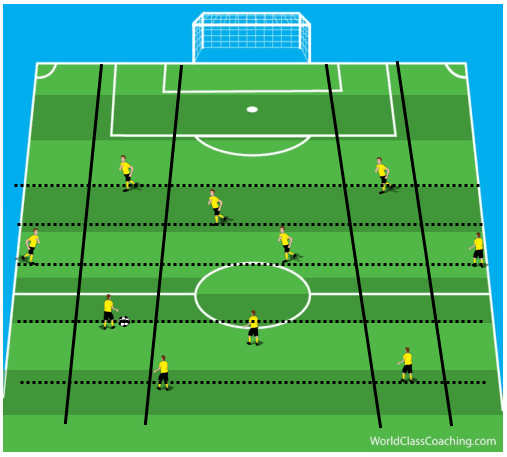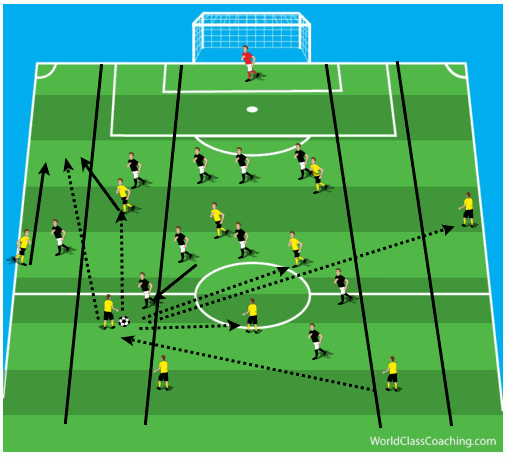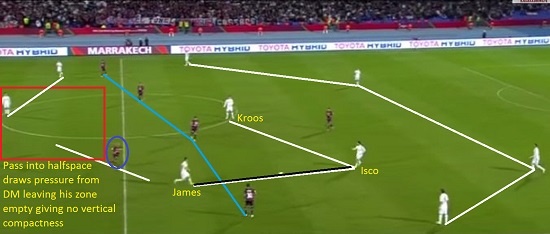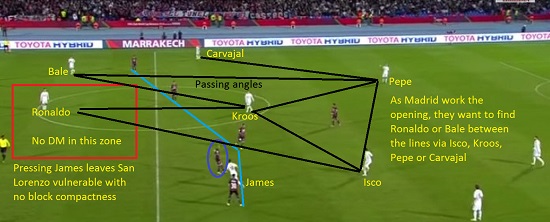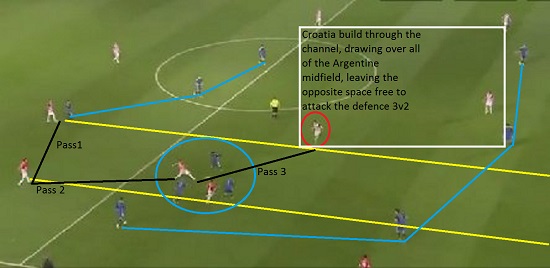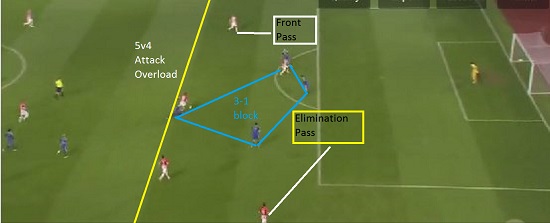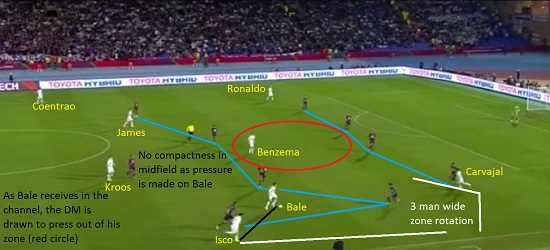By Stevie Grieve
Traditionally in football, the field was separated into 3 clear areas – wide-centre-wide, meaning the specific positional play in possession was fairly static. With a field around 60m wide, this means that each zone is 20m wide, often resulting in large distances between players, particularly in a traditional 4-4-2 formation.
If we split the field into 5 clear channels, this distances of width of each zone becomes 15m and the 5m reduction of distances help layers cover more ground collectively and individually, so the ‘channel’ has become a key zone in terms of build-up play and in how to penetrate through defences.
Using the channel draws over players to press diagonally, and normally results in space being opened up either behind the inside central midfielder or the wide midfielder, and often a defensive midfielder will come higher up to cover the space, leaving the zone between the lines free to be exploited, often temporarily hurting the vertical compactness of the defensive block.
To me, there has been a debate among British coaches and European coaches around the term ‘halfspace’, which is derived from the word ‘haufbraum’ used in Germany from the 1930s to describe ‘the channel’ as it was the area usually occupied by a ‘halfback’, hence the term, ‘halfspace’
For me, there is a difference between the channel and the halfspace;
- The channel is a set strip of field down the field, like the wing or the centre
- The halfspace is a movable space between 2 specific opposition players – wide and centre.
If a player presses out of position to the channel, they press diagonally leaving a space which can be exploited, particularly if the player in possession has 3 clear lines of play ahead of him.
As the ball is switched from channel to channel, the defensive block would need to quickly shift over and stay compact, while moving diagonally to press. There will always be a space available to pass the ball again to. The key is that the player receiving will know where the player he passes to will go next, with either a pass with the back to goal on line 4, a player able to turn and attack the back 4 on line 3, a player on the half turn to penetrate on line 2 or a player to take possession and pass forward on the same line. Often with Real Madrid, Isco or Modric play in the channel, draw pressure then use Kroos inside the centre circle to attack next.
As we can see, the player in the channel has 5 passing options, with a switch to the far side open for the far side full back to have a 3v2 on the side, a pass into the centre via the right central midfielder on line 2, a pass to feet of the left attacking midfielder on line 4 or 3 if he drops in, a pass behind the fullback into the corner, or a possibility to dribble into line 3 himself. If none of the forward options are available for him to give the next player a chance to continue forward, he might pass inside to the player on the same line that has a whole field to use and play forward.
Building from midfield into attack
Once play has been consolidated the midfield look to find a way into the attacking phase against the back 4. Isco passes to James who has drawn diagonal pressure from the DM, who leaves his zone to press James. As James makes a simple pass back to Isco, the ball is where it started 3 seconds ago but now with a hole between defence and midfield, with minimal horizontal compactness across the opposition midfield line, which Real Madrid should be able to penetrate.
As Isco receives the 2nd pass, we can see Ronaldo now has the whole of the #10 zone to himself, with no vertical compactness of the defensive block to be seen. The position of Toni Kroos is excellent, he is infront of the defensive line able to turn and play through to Ronaldo in the #10 zone or Bale in the channel. He could make an easy wide pass to Carvajal who would be expected to push up if Kroos recieves and the wide midfielder would tuck in to mark Bale; if he does not, he passes to Bale.
Drawing pressure to play diagonally between the lines
The build-up away from pressure into the channel draws over all 3 of Argentina’s central midfielders, leaving them exposed in front of the back 4. If the ball can be played diagonally into the player between the lines, Argentina will struggle to recover as the attack could possibly overload.
In the final 30m, Croatia have a 5v4, with Argentina trying to form a narrow 3-1 block to force play wide. As the wide runners are from close to the ball – the near side wide player is in the channel and has less running distance, he can be dangerous with a pass around the defence, while a reverse pass against the body shape of the defence into the yellow box would result in a 2v1 on the GK with the RW and CF.
[wpsharely id="2988"][/wpsharely]Three man wide zone rotation via the channel
As we can see, Bale is in the zone expected of Isco, Carvajal in the zone expected of Bale and Isco in the zone of Carvajal, as all 3 have rotated to fine Bale in the channel.
As the DM again is forced to move over and out of position to press Bale, Benzema is free between the lines to offer a quick diagonal pass from the outside of Bale’s left foot, which would expose the back 4 with Ronaldo on the blindside and Bale running form deep with Carvajal occupying the full back.
Instead, Carvajal moves inside to create the wide space Isco will overlap into.
As Bale is pressed, he can pass inside but with the wide zone free and possibly less risky a pass, especially with 6 players taken out if the ball is lost and in a more dangerous position centrally for a counter attack, the wide pass to Isco on the overlap is the sensible pass with Isco having the ability to make a final pass.
We can see the importance of building through the channel to open up the defence and how we can penetrate if the team is well organised in their position vertically and horizontally.
By Stevie Grieve. (Follow on Twitter @steviegrieve) Stevie is also the author Coaching the 4-2-3-1, Coaching the 4-2-3-1 Advanced Tactics and From Futsal to Soccer

